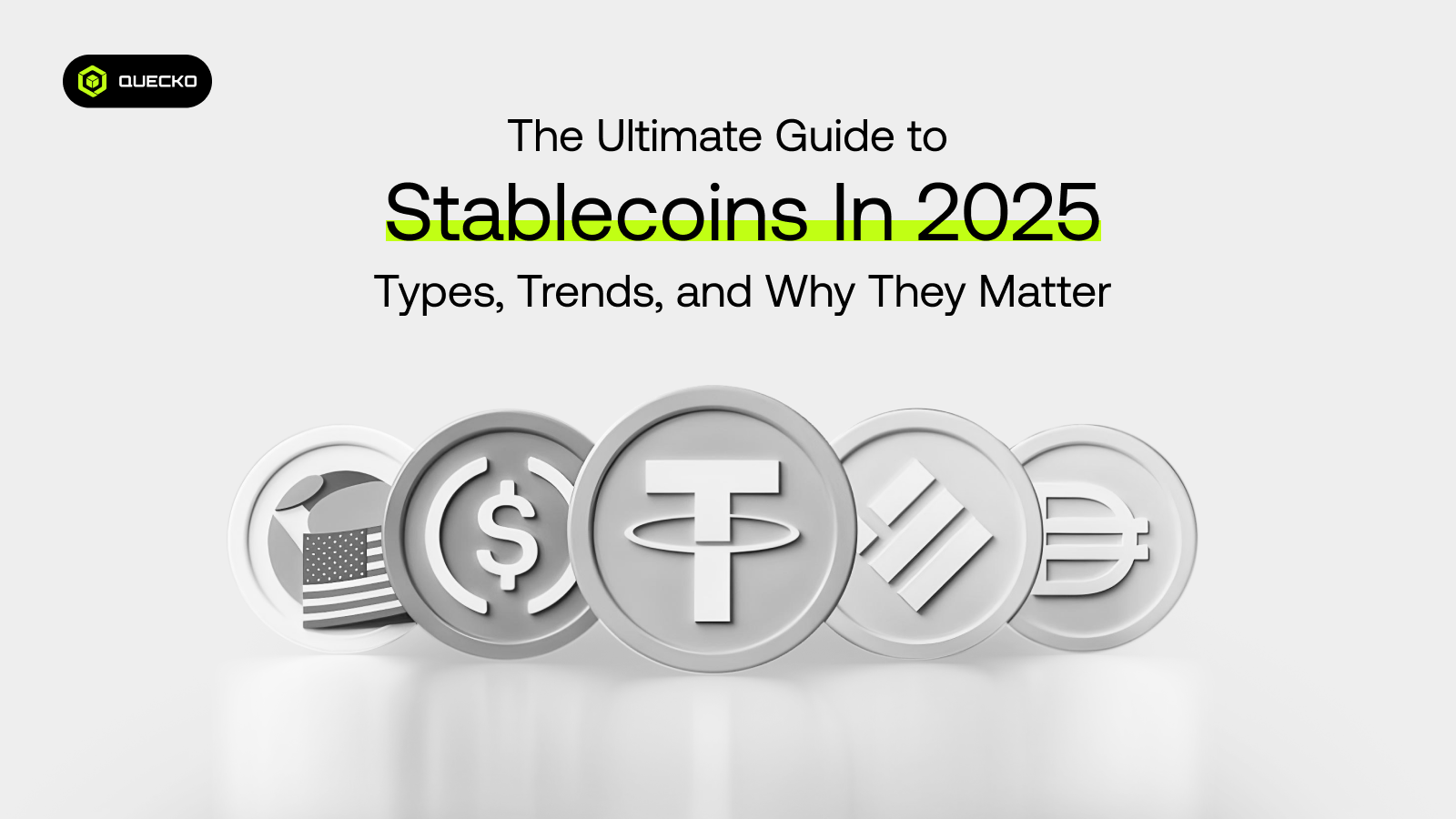The Ultimate Guide to Stablecoins in 2025: Types, Trends, and Why They Matter
Here we’ll break down the different types of stablecoins, uncover their incredible advantages, and address the challenges they face.

Do you know the unsung heroes of the crypto world? By 2025, stablecoins are not just another option; they’re the crucial bridge between wild crypto waves and the calm shores of traditional finance.
Imagine having the best of both worlds stability meets innovation. Whether you’re just dipping your toes into the crypto pool or you’re a seasoned sailor navigating these digital waters, understanding stablecoins is your golden ticket in blockchain technology.
In this blog, we’ll break down the different types of stablecoin, uncover their incredible advantages, and address the challenges they face. Plus, we’ll take a sneak peek at the key trends shaping the future of finance.
Let’s jump in and explore how stablecoins are transforming the financial landscape, making crypto accessible to everyone.
What Are Stablecoins?
Stablecoins are a special type of cryptocurrency designed to maintain a stable value. Unlike Bitcoin or Ethereum, which can experience significant price volatility, stablecoins are pegged to more stable assets, such as traditional fiat currencies like the US dollar, precious metals like gold, or algorithmic mechanisms.
Some popular stablecoins include Tether (USDT), USD Coin (USDC), Dai (DAI), and Binance USD (BUSD), each offering different mechanisms for maintaining price stability. These stablecoins help facilitate seamless transactions, enabling users to store value and conduct business without worrying about extreme market fluctuations.
Why are they so popular?
Stablecoins are gaining popularity for several reasons. Here’s a concise look at why they stand out:
1. Stability: No Wild Price Swings
Stablecoins are designed to maintain a consistent value by being pegged to stable assets like fiat currencies, commodities, or algorithmic mechanisms. This makes them an attractive option for users wanting to avoid the volatility of other cryptocurrencies.
2. Liquidity: Easy to Trade and Use
Stablecoins are highly liquid and can be easily traded on various cryptocurrency exchanges. Their stable value ensures quick conversions into fiat or other cryptocurrencies without significant value loss, making them ideal for everyday transactions and swift trading.
3. Versatility: Perfect for Payments, Savings, and DeFi
Stablecoins are versatile and can be used for cross-border payments, savings, and decentralized finance (DeFi). They provide a seamless way to transfer value, offer a stable store of value, and are crucial for participating in DeFi protocols.
Why use stablecoins?
They offer stability like traditional currencies. You get the benefits of digital currencies. This means security and efficiency with blockchain. No worry about price fluctuations.
In a nutshell, stablecoins provide the best of both worlds: stability and innovation. They’re crucial in the evolving crypto ecosystem. For daily transactions, they are ideal. They offer a reliable medium of exchange.
Moreover, their liquidity ensures easy trading. Their versatility is perfect for payments, savings, and DeFi applications. They also enhance financial inclusion, helping those without bank accounts. With transparent and secure transactions, trust and safety are guaranteed.
Therefore, stablecoins are a stable and efficient solution in digital finance. Whether for transferring value, protecting against inflation, or participating in DeFi, they offer a robust solution.
Now, let’s explore the types of stablecoins you need to know in 2025.
Types of Stablecoins
Stablecoins are a type of cryptocurrency designed to minimize price volatility by being pegged to a stable asset, such as a fiat currency, cryptocurrency, commodity, or even an algorithmic mechanism. This stability makes them a popular choice for traders, investors, and consumers who seek a reliable store of value and medium of exchange in the often volatile crypto market.
Here are the different types of stablecoins:1- Fiat-Collateralized Stablecoins
2- Crypto-Collateralized Stablecoins
3- Algorithmic Stablecoins
4- Commodity-Collateralized Stablecoins
5- Hybrid Stablecoins
1. Fiat-Collateralized Stablecoins: The OG of Stability
Fiat-collateralized stablecoins are the most common type of stablecoins in the crypto world. These digital currencies are backed 1:1 by fiat currencies such as the US dollar, euro, or yen, which are held in reserve by the issuing company or a trusted custodian. This means for every stablecoin issued, there is an equivalent amount of fiat currency held in reserve.
Key Features
- Stability: Since they are pegged to stable fiat currencies, they provide a reliable value that doesn’t fluctuate wildly like other cryptocurrencies.
- Liquidity: Highly liquid and easily tradable, they are widely accepted across various exchanges and platforms.
- Trust: The backing of real-world assets gives users confidence in their value and stability.
Examples
- USDT (Tether): The most widely used stablecoin, Tether has a significant presence in trading and offers quick liquidity.
- USDC (USD Coin): Known for its regulatory compliance and transparency, USDC provides audited reports of its reserves.
- BUSD (Binance USD): Backed by the major crypto exchange Binance, BUSD is popular for trading and staking.
Why they’re Popular
- Trustworthiness: Backed by tangible assets, users feel secure knowing that their stablecoins are backed by actual fiat currency reserves.
- Widespread Acceptance: These stablecoins are accepted by most exchanges, making them highly practical for traders and investors.
- Ease of Use: Simple mechanism and easy to understand, they are a go-to option for many users new to the crypto space.
Challenges
- Centralization: These stablecoins rely on centralized entities to hold and manage the fiat reserves, which introduces a single point of failure and requires trust in these entities.
- Regulation: Being closely monitored by governments and regulators, these stablecoins may face regulatory hurdles and compliance issues.
- Transparency: Users must trust that the issuing companies are maintaining adequate reserves and providing transparent, regular audits.
- Counterparty Risk: The value of the stablecoins depends on the financial health and integrity of the companies holding the reserves.
Fiat-collateralized stablecoins are foundational to the crypto ecosystem, offering a stable and reliable digital currency option for trading, payments, and DeFi applications.
2. Crypto-Collateralized Stablecoins: Decentralized and Innovative
These stablecoins are backed by other cryptocurrencies. To account for volatility, they’re often overcollateralized, meaning more collateral is held than the value of the stablecoins issued. This over collateralization acts as a buffer against price drops of the underlying assets, ensuring the stablecoin maintains its peg.
Key Features
- Decentralization: Unlike fiat-collateralized stablecoins, crypto-collateralized stablecoins are often managed by decentralized autonomous organizations (DAOs) through smart contracts, reducing reliance on any single entity.
- Transparency: The backing collateral and issuance process are visible on the blockchain, allowing anyone to verify the reserves and the stability mechanisms.
- Flexibility: Can be quickly adjusted to market conditions through programmable smart contracts, which can automatically execute re-collateralization when needed.
Collateral Management
- Overcollateralization: To mitigate volatility risks, these stablecoins require users to lock up more collateral than the value of the stablecoins they receive. For instance, to mint $100 worth of a stablecoin, one might need to lock up $150 worth of Ethereum.
- Liquidation Mechanisms: If the value of the collateral drops below a certain threshold, the smart contracts can trigger automatic liquidation to maintain the peg and ensure the stablecoin’s stability.
- Interest and Incentives: Some platforms offer interest or other incentives to users who provide collateral, encouraging more participation and boosting the liquidity of the stablecoin.
Risks and Challenges
- Volatility of Collateral: The value of the backing cryptocurrencies can fluctuate wildly, posing a risk to the stability of the stablecoin.
- Complexity: The mechanisms required to maintain stability can be intricate, requiring robust smart contract design and constant monitoring.
- User Trust: Users need to trust the underlying protocols and the efficacy of the automated systems managing the collateral.
Real-World Applications
- DeFi Ecosystems: Crypto-collateralized stablecoins are extensively used in decentralized finance (DeFi) platforms for lending, borrowing, and earning interest.
- Cross-Border Transactions: They facilitate seamless, low-cost cross-border transactions without the need for traditional banking infrastructure.
- Savings and Payments: Users can utilize these stablecoins for everyday payments and as a store of value, leveraging their stability and decentralization.
Crypto-collateralized stablecoins represent a fascinating blend of innovation and stability, pushing the boundaries of what’s possible in the decentralized finance space.
3. Algorithmic Stablecoins: The Future or a Gamble?
Algorithmic stablecoins use smart contracts and algorithms to maintain their peg. They’re not backed by collateral but rely on supply and demand mechanics. Let’s dig deeper!
Key Features
- Dynamic Supply Adjustment: These stablecoins adjust their supply automatically based on demand to maintain their value. If the price rises above the target, the supply increases. If it falls below, the supply decreases.
- Decentralized: Operate without the need for centralized reserves, using decentralized protocols to manage their stability.
- Innovation: Explore unique financial models and mechanisms to maintain stability and adapt to market conditions.
Examples
- UST (TerraUSD): Once a prominent algorithmic stablecoin, it collapsed in 2022, highlighting the risks involved in algorithmic stability.
- FRAX: Combines algorithmic mechanisms with collateral to maintain its peg, offering a hybrid approach to stability.
How They Work
- Supply and Demand Mechanics: Algorithmic stablecoins use smart contracts to automatically adjust the supply based on the token’s market price. If the price exceeds the target value, new tokens are minted and distributed to decrease the price. Conversely, if the price drops, tokens are bought back and burned to increase the price.
- Rebase Mechanisms: Some algorithmic stablecoins use rebasing, where the supply of the stablecoin in users’ wallets is adjusted periodically to align with the target price.
Advantages
- Capital Efficiency: No need for large reserves, freeing up capital for other uses.
- Decentralization: Reduces reliance on central entities and promotes a decentralized financial ecosystem.
- Scalability: Can potentially scale without the constraints of physical or crypto collateral.
Challenges
- Risk of Failure: The reliance on algorithms and market dynamics can fail during extreme volatility, as seen with the collapse of UST.
- Complexity: The mechanisms can be difficult for users to understand, requiring trust in the protocol and its design.
- Market Trust: Building and maintaining user trust can be challenging, especially after high-profile failures.
- Regulatory Scrutiny: As with other stablecoins, algorithmic stablecoins face regulatory uncertainty and scrutiny.
Algorithmic stablecoins are a fascinating experiment in decentralized finance, balancing on the edge of innovation and risk. They offer a glimpse into the future of financial technology but also come with significant challenges and uncertainties.
4. Commodity-Collateralized Stablecoins: Backed by Real Assets
These stablecoins are backed by physical assets like gold, silver, or real estate. They offer a tangible guarantee of value, which can be appealing to those wary of purely digital assets.
Key Features
- Tangible Guarantee: Provides a sense of security as they are backed by physical, real-world assets.
- Inflation Hedge: Helps protect against the devaluation of fiat currencies by holding value in commodities that traditionally appreciate over time.
- Asset Diversification: Adds an extra layer of diversification to a crypto portfolio by linking the stablecoin’s value to commodities like gold or real estate.
- Transparency: Issuers often provide regular audits and detailed reports on the reserves, ensuring that the stablecoins are fully backed by the physical assets they claim.
Examples
- PAX Gold (PAXG): Each token represents one ounce of gold, providing a direct link to the precious metal.
- Tether Gold (XAUT): Another gold-backed option, giving investors a stablecoin with the value of gold.
Why They’re Popular
- Tangible Value: Backed by real-world assets, offering a sense of security and stability.
- Inflation Hedge: Protects against fiat currency devaluation, acting as a store of value in uncertain times.
- Diversification: Provides an alternative to fiat or crypto-backed stablecoins, adding variety to investment portfolios.
- Trust: Investors find comfort in knowing their digital currency is backed by physical, tangible assets.
Challenges
- Liquidity: Less liquid than fiat-backed stablecoins, making transactions slower and potentially more expensive.
- Storage Costs: Physical assets need to be stored securely, which can be costly and logistically challenging.
- Trust in Custodians: Requires trust in the entities managing and storing the physical assets.
- Regulatory Considerations: Subject to regulations related to the underlying physical assets.
- Market Risks: Value tied to market prices of commodities, which can still fluctuate.
Commodity-collateralized stablecoins offer a unique blend of digital convenience and physical security, making them an attractive option for those looking to hedge against volatility and inflation.
5. Hybrid Stablecoins: The Best of Both Worlds
Hybrid stablecoins combine multiple mechanisms to maintain stability. For example, they might use both collateral and algorithms to ensure their value remains steady.
Key Features
- Dual Mechanisms: Utilizes both collateral (either fiat, crypto, or commodities) and algorithmic adjustments to maintain a stable value.
- Flexibility: Adapts to changing market conditions by dynamically balancing between collateral and algorithmic mechanisms.
- Resilience: Aims to combine the reliability of collateral-backed systems with the efficiency and innovation of algorithmic models.
Examples
- FRAX: Partially collateralized and partially algorithmic, offering a blend of stability mechanisms.
- Reserve Rights (RSV): A mix of collateral and algorithmic adjustments, providing a flexible approach to maintaining value.
Why They’re Popular
- Balanced Approach: Combines the benefits of collateralized and algorithmic stablecoins, offering a more robust stability solution.
- Innovative: Pushes the boundaries of stablecoin design, exploring new ways to achieve and maintain stability.
- Flexibility: Can adapt to market conditions more dynamically, using both collateral and algorithmic adjustments.
- Efficiency: Offers the potential for capital efficiency without locking up too much collateral.
Challenges
- Complexity: Harder to design, maintain, and understand compared to simpler stablecoin models.
- Risk: Still experimental in many cases, with potential vulnerabilities in both the collateral and algorithmic mechanisms.
- Regulatory Uncertainty: Faces evolving regulatory landscapes, which can impact their development and adoption.
- User Trust: Requires trust in both the collateral and the algorithmic mechanisms to maintain stability.
Hybrid stablecoins represent an exciting frontier in the stablecoin space, blending traditional and innovative approaches to create a more resilient and adaptable digital currency.
Key Trends in 2025
As we look towards 2025, several key trends are shaping the future of stablecoins:
- Regulation: Governments are cracking down on stablecoins, ensuring transparency and security. This includes implementing clear regulatory frameworks and licensing requirements to protect investors and maintain financial stability.
- Interoperability: Stablecoins are becoming cross-chain, working on multiple blockchains. This allows for seamless transactions and greater flexibility across different blockchain platforms.
- DeFi Integration: Stablecoins remain the backbone of decentralized finance (DeFi). They provide a stable medium of exchange and store of value, enabling various DeFi applications and financial products.
- Sustainability: Eco-friendly stablecoins are on the rise, using energy-efficient blockchains. This trend addresses environmental concerns associated with cryptocurrency mining and promotes sustainable practices in the crypto space.
- Localized Stablecoins: There is a growing trend towards localized stablecoins tied to local currencies. These stablecoins aim to digitize local economies, enhance financial inclusion, and streamline digital payments.
- Public-Private Partnerships: Collaborations between regulators, financial institutions, and technology providers are driving innovation in the stablecoin space. These partnerships help integrate stablecoins into the global financial system and foster regulatory clarity.
- Expansion of Use Cases: Stablecoins are being adopted for a wider range of use cases, including cross-border payments, remittances, and everyday transactions. Their versatility and stability make them attractive for various financial applications.
- Central Bank Digital Currencies (CBDCs): The development of CBDCs is influencing the stablecoin market. Some countries are exploring the integration of stablecoins with their national digital currencies to enhance financial systems.
These trends highlight the evolving landscape of stablecoins in 2025, showcasing their growing importance and potential for innovation in the global financial system.
Why Stablecoins Matter in 2025
Stablecoins are more than just a crypto trend. They’re a financial revolution. Here’s why:
- Global Payments: Fast, cheap, and borderless. Stablecoins enable instantaneous cross-border transactions without the high fees and delays associated with traditional banking systems. This opens up new possibilities for international trade and remittances.
- Financial Inclusion: Accessible to the unbanked. Stablecoins provide a gateway to financial services for the unbanked and underbanked populations around the world. With just a smartphone and internet connection, individuals can access stable financial instruments and participate in the global economy.
- DeFi Growth: Essential for lending, borrowing, and trading. In the world of decentralized finance (DeFi), stablecoins are a cornerstone. They offer a stable medium of exchange and store of value, facilitating lending, borrowing, yield farming, and trading on various DeFi platforms.
- Hedge Against Volatility: Protects investments from the wild price swings of other cryptocurrencies. Stablecoins provide a haven for investors during market turbulence, allowing them to preserve the value of their assets without exiting the crypto ecosystem.
- Ease of Use: User-friendly and straightforward. Unlike other digital assets that can be complex to manage, stablecoins are simple to understand and use, making them accessible to a broader audience.
- Integration with Traditional Finance: Bridging the gap between traditional finance and crypto. Stablecoins are increasingly being integrated into existing financial systems, enabling seamless interactions between fiat currencies and digital assets.
These points illustrate how stablecoins are transforming the financial landscape in 2025, making them an integral part of the future of finance.
Final Thoughts
Stablecoins have truly become the backbone of the financial ecosystem. As we approach 2025, it’s clear that these digital assets are not just a fleeting trend but a game-changing innovation. Their evolution into diverse, regulated, and indispensable financial tool showcases their resilience and adaptability.
In my opinion, stablecoins represent the perfect blend of stability and innovation. They bridge the gap between traditional finance and the rapidly evolving world of cryptocurrencies. Whether you’re utilizing them for seamless global payments, secure savings, or diving into the dynamic realm of DeFi, stablecoins offer unparalleled benefits.
Understanding the various types and key trends of stablecoins is more important than ever. They are not just another financial instrument; they are paving the way for a more inclusive, efficient, and innovative financial future. As we continue to witness their growth and integration, stablecoins are set to play an even more critical role in our daily financial lives.
So, let’s hold this financial revolution and stay ahead of the curve. The future of finance is here, and stablecoins are leading the charge!
Date
10 months agoShare on
Related Blogs

How Blockchain Is Rewiring Corporate Banking
1 month ago

How Businesses Can Build Scalable DApps and Smart Contracts
1 month ago

Hot vs Cold Wallets: Which One To Trust With Your Crypto in 2025?
1 month ago

Here is What Successful Web3 Startups Have in Common
2 months ago








